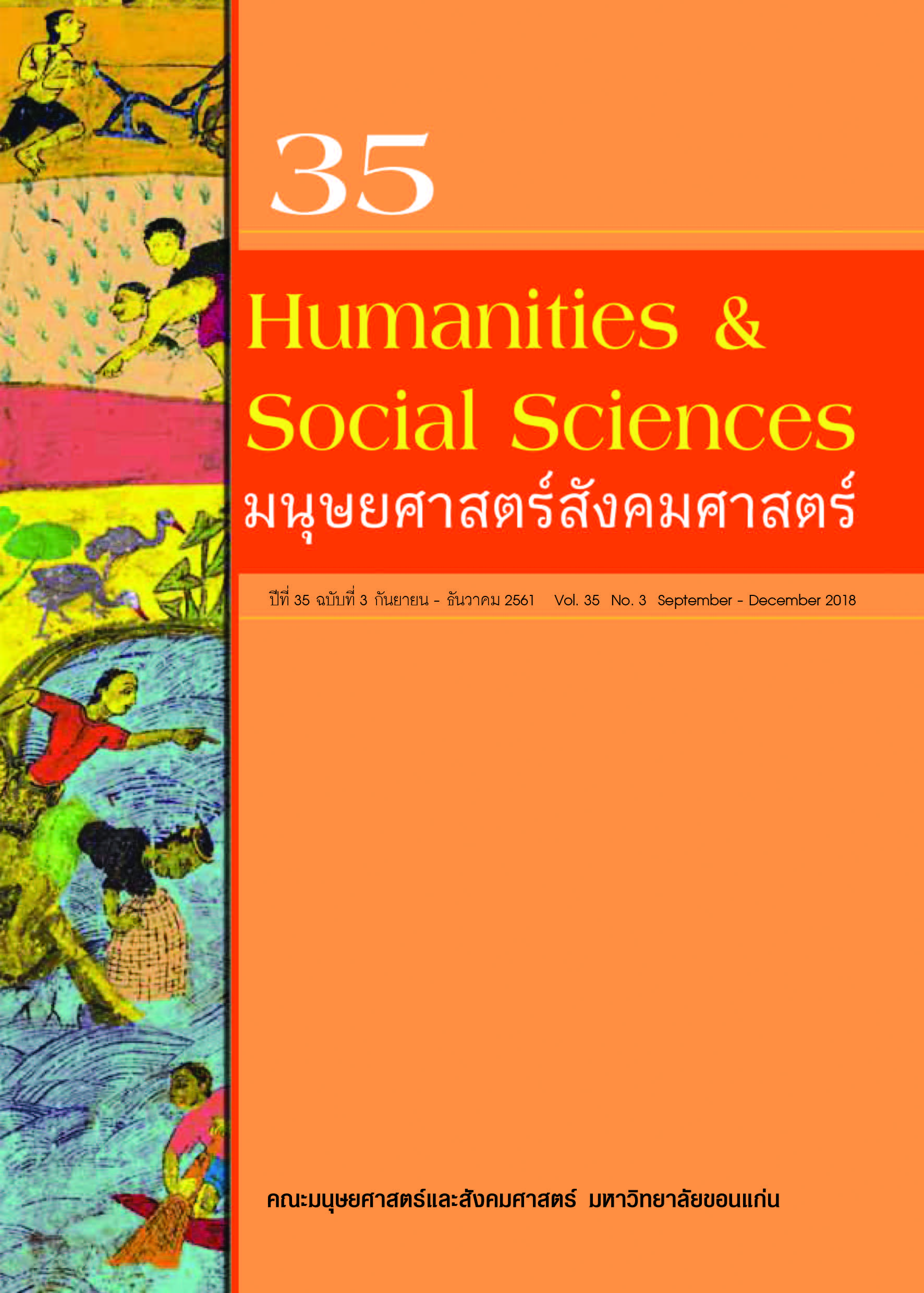การพัฒนาทักษะการสื่อสารทางด้านการพูดของแพทย์ประจำบ้านชาวไทยโดยเน้นการพูดเป็นจังหวะตามแบบภาษาอังกฤษโดยใช้สถานการณ์รูปแบบจำลองในวิชาชีพด้านการแพทย์: กรณีศึกษา / Enhancing Oral Communication Skills of Thai Medical Residents Focusing on English Rhythm through Medical- Profession Simulations: A Case Study
Keywords:
Oral communication skills, Thai medical residents, English rhythm, Medical-Profession Simulations, ทักษะการสื่อสารด้านการพูด, แพทย์ประจำบ้านชาวไทย, จังหวะในการพูดภาษาอังกฤษ, สถานการณ์รูปแบบจำลองด้านการแพทย์Abstract
According to the progressive policies of Thailand, the Board of Investment has stated that Thai government aims for “Thailand, a Hub of Wellness and Medical Services” to be achieved within a ten year time frame from 2016-2025. It has also claimed that “Thailand is well-positioned to be the medical hub of Asia” with its outstanding medical foundation including premium medical services, qualified healthcare specialists and various internationally accredited medical facilities. Thailand aims to become the 1st of top destinations as a world leader of medical tourism with over a million international patients travelling to Thailand every year on medical travel packages; its numbers of foreign patients keeps growing annually due to its medically renowned worldwide or global reputation services for graceful and attentive services. To strengthen Thailand’s position as the medical hub of Asia, medical doctors’ English oral communication skills need to be improved urgently since most Thai learners have great difficulty in English communication at all educational levels due to the different features between Thai and English languages. At Khon Kean University, sixty - two medical residents have been trained to improve oral skills emphasizing English rhythm via professional simulations in a forty- five hour -Technical English for Medical Residents course in the 2nd semester of the academic year 2016. The findings showed almost all of the medical residents’ oral communication skills did appear to improve significantly reflected through a higher level of intelligible connected speech. That is their connected speech is more fluent and natural. This includes their higher confidence in English oral communication. Also, their awareness in developing their own oral communication ability through self-assessments has been substantially raised with better attitudes to and motivation for producing connected speech with English rhythm.
บทคัดย่อ
ตามนโยบายส่งเสริมความก้าวหน้าทางด้านเศรษฐกิจของประเทศไทย สำนักงานคณะกรรมการส่งเสริมการลงทุนกล่าวว่า รัฐบาลไทยมีเป้าหมายที่จะทำให้ประเทศไทยกลายเป็นศูนย์กลางการบริการทางด้านสุขภาพและการแพทย์ภายในเวลา10ปี นับจากปี 2563 ถึงปี 2572 และยังได้กล่าวต่อไปว่าประเทศไทยมีสถานภาพที่เหมาะสมที่จะเป็นศูนย์กลางการแพทย์ของเอเชียเพราะมีพื้นฐานทางการแพทย์ที่โดดเด่น รวมทั้งการให้บริการทางการแพทย์ที่ยอดเยี่ยมและมีแพทย์ผู้เชี่ยวชาญในการรักษาที่มีคุณภาพสูงหลากหลายสาขา รวมไปถึงมีโรงพยาบาลที่ได้รับการยอมรับระดับนานาชาติมากมายในประเทศ ดังนั้นประเทศไทยจึงมีเป้าหมายที่จะกลายมาเป็นจุดหมายปลายทางอันดับ 1 ของนักท่องเที่ยวในตลาดอุตสาหกรรมการท่องเที่ยวเชิงสุขภาพของโลก แม้ขณะนี้ประเทศไทยเองในแต่ละปีมีผู้ป่วยจากหลากหลายประเทศที่เดินทางมาในรูปแบบแพคเกจทัวร์ทางด้านการแพทย์เกินกว่า 1 ล้านคนต่อปี และจำนวนของผู้ป่วยต่างชาติที่เข้ามารับการรักษาพยาบาลก็เพิ่มขึ้นทุกปี เพราะการบริการทางด้านการแพทย์ของประเทศไทยมีชื่อเสียงเป็นที่ยอมรับทั่วโลก ในด้านการดูแลผู้ป่วยที่เต็มไปด้วยการให้เกรียรติและการเอาใจใส่ดีเป็นเลิศ ในการที่จะช่วยส่งเสริมให้ประเทศไทยสามารถที่จะเป็นศูนย์กลางการแพทย์ของเอเชียตามที่ตั้งเป้าไว้ การสื่อสารทางด้านการพูดภาษาอังกฤษของแพทย์ชาวไทยจำเป็นจะต้องมีการปรับปรุงอย่างเร่งด่วนเพราะคนไทยมีปัญหาในการสื่อสารเป็นภาษาอังกฤษในทุกระดับ เนื่องจากลักษณะที่แตกต่างกันอย่างมากระหว่างภาษาไทยและภาษาอังกฤษ ดังนั้นงานวิจัยนี้จึงจัดทำขึ้นเพื่อพัฒนาการสื่อสารทางด้านการพูดของแพทย์ประจำบ้านที่กำลังศึกษาและทำงานอยู่โรงพยาบาลศรีนครินทร์, มหาวิทยาลัยขอนแก่น ผู้เข้าร่วมวิจัยคือ แพทย์ประจำบ้านหกสิบคนจากสองห้องเรียน ในวิชาภาษาอังกฤษเพื่อแพทย์ประจำบ้านในภาคการศึกษาที่ 2 ของปีการศึกษา 2559 งานวิจัยมีวัตถุประสงค์เพื่อพัฒนาทักษะการสื่อสารทางด้านการพูดของแพทย์ประจำบ้านชาวไทยโดยเน้นการพูดเป็นจังหวะตามแบบภาษาอังกฤษโดยใช้สถานการณ์รูปแบบจำลองในวิชาชีพด้านการแพทย์ ผลการวิจัยแสดงให้เห็นว่าเกือบจะทั้งหมดของแพทย์ประจำบ้านสามารถพัฒนาทักษะทางด้านการพูดได้อย่างดีหลังจากจบงานวิจัยผู้เข้าร่วมวิจัยสามารถพูดสื่อสารเป็นภาษาอังกฤษที่ทำให้ผู้ฟังเข้าใจได้มากยิ่งขึ้นเพราะพูดภาษาอังกฤษได้คล่องและเป็นธรรมชาติมากขึ้น พร้อมทั้งมีความมั่นใจในการพูดสื่อสารเป็นภาษาอังกฤษมากยิ่งขึ้น ยิ่งกว่านี้แพทย์ประจำบ้านเหล่านี้มีความตระหนักมากขึ้นในการที่จะพัฒนาทักษะการสื่อสารภาษาอังกฤษด้วยตัวเองมากยิ่งขึ้น จากการที่ได้ประเมินทักษะการพูดภาษาอังกฤษด้วยตัวเอง พร้อมทั้งมีทัศนะคติและแรงบันดาลใจมากขึ้น ในการพูดภาษาอังกฤษที่มีจังหวะที่ถูกต้องตามแบบเจ้าของภาษา
References
Bowler, B., Cunningham, S., Moor, P., & Parminter, S. (2000). New headway pronunciation course. Oxford: Oxford University Press.
Brown, G. (1990). Listening to spoken English. Applied linguistics and language study. 2nd ed. London: Longman.
Celce-Murcia, M., & Olshtain, E. (2000). Phonology. In Discourse and context in language teaching: a guide for language teachers. (pp. 30–49). Cambridge: Cambridge University Press.
Davis, R. (1995). Simulations: A tool for testing" virtual reality" in the language classroom. Retrieved August 3, 2014, from https://bit.ly/2D6WAs1
Nithiwat, G. (2017). Accessible Thailand, The disabled travelers’essential guide to Thailand. Retrieved July 15, 2017, from https://bit.ly/2NSMAHd
Kelly, G. (2000). How to teach pronunciation. Harlow: Longman.
Konetes, G. D. (2010). The function of intrinsic and extrinsic motivation in educational virtual games and simulations. Journal of Emerging Technologies in Web Intelligence, 2(1), 23–26.
Krashen, S. D. (1981). Second language acquisition and second language learning. Language teaching methodology series. Oxford: Pergamon Press.
Lyu, Y. (2006). Simulations and second/foreign language learning: improving communication skills through simulations. Master thesis of Arts degree in English, University of Toledo, U.S.A.
Maurice, K. (1986). Speed up your speaking classes: two techniques aimed at fluency. In K. Prapphal, S. Wongbiasaj, & Maurice K. (Eds.).Methods and techniques that work. (pp. 2–15). Bangkok: A.U.A. Language Center.
McCullagh, M., & Wright, R. (2008). Good practice: communication skills in English for the medical practitioner. Teacher’s book. Professional English. Cambridge: Cambridge University Press.
Naranong, V. (2018, January 3). Medial tourism, a report from the Tourism Review News Channel. Samui Times. Retrieved January 5, 2018, from https://bit.ly/2NUuODq
Nokaew, P., & Ruanklai, S. (2010). A study of syllable division, stress placement, and rhythm in English connected speech among second year English-major students at Chiang Mai University. Chiang Mai: Faculty of Humanities, Chiang Mai University.
Sumdangdej, S. (2007). Input and the acquisition of suprasegmental phonology in English by Thai school children. Ph.D. Dissertation, Department of English Language and Linguistics, Durham University, England.
Sumnugnod, N., & Chaluaisaeng, B. (2015). Meeting specific English oral communication needs of Thai learners through interactive self-initiated simulations for oral skill improvement. Journal of Graduate Study in Humanity and Social Sciences. 4(1), 149–168.
Swain, M. (2005). The output hypothesis: theory and research. In E. Hinkel (Ed.).Handbook of research in second language teaching and learning. (pp. 471–484.). Mahwah, NJ: Lawrence Erlbaum Associates.
Tantiwong, P. (2009). Simulation as a strategy to teach English for tourism. Retrieved July 8, 2009, from https://bit.ly/2Oy2a8b
Taweepon, P., & Chalauisaeng, B. (2017). Improving English speaking skill focusing on rhythm through series of self-recorded video tasks: a case study at RMUTI, Khon Kaen. GEN TEFL Journal. 2(1), 53–61.
Taylor, J. L., & Walford, R. (1972). Simulation in the classroom: an introduction to a role-play, games and simulation in education. Harmondsworth: Penguin.
Tomlinson, B., & Masuhara, H. (2009). Research in materials development: Evidence for good practice. London: Continuum.
Tompskins, P. K. (2011). Role playing/Simulation. Retrieved July 5, 2011, from https://bit.ly/2OxVDu5
Tufte, E. R. (1997). Visual explanations: images and quantities, evidence and narrative. Cheshire: Graphics Press.



